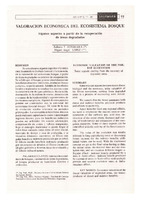Valoración económica del ecosistema bosque : algunos aspectos a partir de la recuperación de áreas degradadas
Economic valuation of the forest ecosystem : Some aspects starting from the recovery of degraded áreas
Abstract
Se consideraron algunos aspectos relevantes entre la naturaleza (biología forestal) y la economía, en la valoración del ecosistema bosque, a partir de áreas degradadas en proceso de recuperación. Se refleja que el bosque genera simultáneamente beneficios directos e indirectos, productos físicos y efectos, respectivamente. Además de los efectos locales y regionales se resaltan los macros como la concentración del gas carbónico, lluvia ácida, destrucción de la cadena de ozono, disminución y escasez de la biodiversidad y agotamientos de los recursos energéticos. Algunos de estos aspectos pueden ser controlados con la actividad del ecosistema forestal bosque. El valor de la tasa de evolución resulta relevante en períodos prolongados. La valoración de beneficios directos puede realizarse capitalizando costos o descontando ingresos futuros; para los beneficios indirectos pueden ser utilizados los valores adicionales, compensación de costos y valores marginales. Bajo el concepto tradicional se puede llegar al valor final teniendo como datos al valor inicial, intervalo de tiempo y tasa de evolución, y se visualiza diferentes escenarios: a) Efecto singular-beneficio indirecto producido por un árbol;
b) Efecto escala-beneficio indirecto producido por un conjunto de árboles;
c) Efecto escala con múltiples períodos y diversas tasas de evolución y
d) Efecto infraestructura. Sorne relevant aspects between nature (forest biology) and the economy, ín the valuation of the forest ecosystem, starting from degraded areas in a process of recovering were considered.
We remark that the forest generales both direct and indirect benefits, physical products and effects respectively.
Apart from the local and regional effects, we have to emphasize the macros ones as concentration of the carbonic gas, acid rain, destruction of the ozone chain, decrease and scarcity of biodiversity and exhaustion of the energetics resources. Sorne of these aspects can be controlled with the activity of the forest ecosystem.
The value of Lhe evolution rate results relevant in long capitalizing costs or discounting future income; for the indirect benefits additional values can be used . With the traditional concept we get to the final value having as data, the initial value the interval time and the evolution rate, and we visualize different stages: a Singular effect - indirect benefit produced by a tree;
b- Scale effect - indirect benefit produced by a group of trees;
c- Scale effect with multiple periods and several evolution rates;
d- infrastructure effect.
Collections
- Revista Yvyraretá [360]
The following license files are associated with this item:




